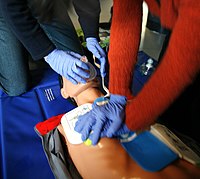
Photo from wikipedia
Supplemental digital content is available in the text. Objective This study focuses on the characteristics (feasibility, resuscitation quality, and physical demands) of infant cardiopulmonary resuscitation (CPR) on the forearm during… Click to show full abstract
Supplemental digital content is available in the text. Objective This study focuses on the characteristics (feasibility, resuscitation quality, and physical demands) of infant cardiopulmonary resuscitation (CPR) on the forearm during fast walking, performed by a trained lay rescuer. Methods Twenty-one university students from the infant education degree participated in a randomized crossover simulation study to compare a standard pediatric CPR versus a walking pediatric CPR with a manikin on the rescue forearm. Each rescuer performed 2 resuscitation tests of 2 minutes on the infant manikin. Cardiopulmonary resuscitation, physiological, and perceived effort variables were measured. Results The quality of chest compressions was higher in standard pediatric CPR than in walking pediatric CPR (72% vs 51%; P < 0.001) and overall CPR quality (59% vs 49%; P = 0.02). There were no differences between ventilation quality (47% vs 46%). Walking pediatric CPR presented a higher percentage of maximum heart rate (52% vs 69%; P < 0.001) and perceived exertion rate (2 vs 5; P < 0.001). Participants walked an average of 197 m during the test. Conclusions In conclusion, pediatric walking CPR is feasible although it represents a slight quality decrease in a simulation infant CPR setting. The option “CPR while walking fast to a safe place” seems to be suitable in terms of safety both for the victim and the rescuer, as well as CPR quality in special circumstances.
Journal Title: Pediatric Emergency Care
Year Published: 2022
Link to full text (if available)
Share on Social Media: Sign Up to like & get
recommendations!